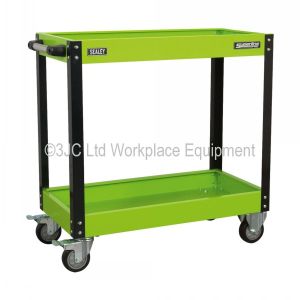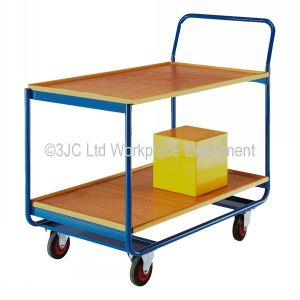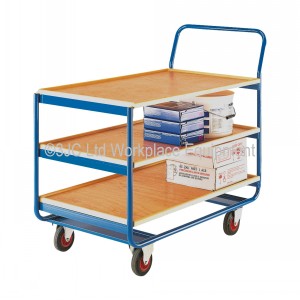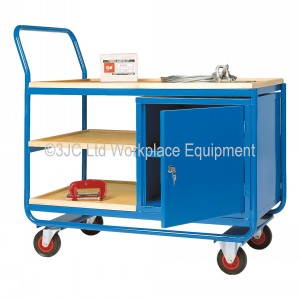How to Choose the Right Workshop Trolley for Your Specific Needs
Selecting the Perfect Workshop Trolley: A Comprehensive Guide
Choosing the ideal workshop trolley can be a challenging task, especially with the plethora of options available in the market. This comprehensive guide will help you make an informed decision and choose a workshop trolley that not only meets your specific needs but also enhances your productivity.
Understanding the Importance of Workshop Trolleys
Workshop trolleys are a crucial component of any workspace. They offer a mobile solution, allowing you to transport tools and materials easily while maintaining a well-organised workspace. These trolleys come in various forms, including work trolleys with an open structure and tool trolleys equipped with differently-sized drawers.
Key Advantages of Using Workshop Trolleys
1. Mobility and Flexibility: With their sturdy and flexible caster wheels, workshop trolleys can easily move around in the workspace, ensuring that your tools are always within reach.
2. Durability and Robustness: Painted with epoxy powder to resist wear and corrosion, these trolleys are designed to withstand the demanding conditions of a workshop.
3. Efficient Organisation: Equipped with spacious drawers and shelves, these trolleys provide ample space for storing small tools, measuring instruments, and other essential items.
4. Safety and Security: Quality workshop trolleys come with lock mechanisms, ensuring the safety of your tools and documents.
Factors to Consider when Choosing a Workshop Trolley
When it comes to selecting the right workshop trolley, several factors need to be taken into consideration.
1. Working Environment
Consider the conditions of your workspace. If the trolley needs to be pushed over rough or uneven surfaces, a model with larger, more durable wheels would be ideal.
2. Load Requirements
Evaluate the size and weight of the load that the trolley will be lifting. If the trolley needs to handle heavy-duty tasks or negotiate stairs, choose a model specifically designed for these purposes.
3. User Characteristics
Consider the physical characteristics and abilities of the people who will be using the trolley. If your staff includes individuals of varying heights and strengths or those with physical impairments, choose a trolley with ergonomic handles to minimise the risk of injury.
4. Quality and Durability
Always opt for a high-quality, durable workshop trolley. While cheaper options may seem appealing, they may not be as safe or capable of handling the same volume of work.
5. Aesthetics
If the trolley is going to be visible to clients or guests, it should look professional and appealing. Choose a workshop trolley that complements the aesthetics of your workspace.
6. Safety Features
Safety should always be a priority. Ensure that the trolley has adequate safety features like brakes and is in good working order.
7. Maintenance and Cleaning
The trolley should be easy to maintain and clean. Opt for a trolley made from materials that can withstand heavy usage and can be easily cleaned.
Different Types of Workshop Trolleys
Depending on your specific needs, you can choose from various types of workshop trolleys.
1. Hand Trolleys
Featuring a solid base, two wheels, and a strong back, hand trolleys allow workers to stack boxes, tilt them slightly, and transport them easily.
2. Platform Trolleys
Platform trolleys, arguably the most common type, feature a four-wheel chassis with handles on both ends and a flat platform. They can be open or caged and can carry varying weight capacities.
3. Shelf Trolleys
Shelf trolleys are essentially platform trolleys equipped with shelves. These trolleys allow for the transportation of multiple items of different sizes, with some models capable of carrying up to 500kg.
4. Wagon Trolleys
Resembling wagons, these trolleys are designed for transporting heavier items. They feature pneumatic wheels that provide excellent stability and mobility.
5. Tote Trolleys
Tote trolleys consist of a metal frame that sits on a workshop trolley cart and holds boxes. They come with wheels that make them easy to move.
The 3 Best Workshop Trolleys for Ultimate Organisation and Efficiency
While workshop trolleys are designed to enhance productivity and convenience, it’s essential to use them safely to prevent accidents and injuries in the workspace.
1. Sealey Workshop Trolley
2 Tier Sealey Workshop Trolley
https://www.3jc.co.uk/shop/sealey-workshop-trolley-2-tier-M7558)
Perfect for commonly used workshop materials like body repair kits, power tools, and large equipment that doesn’t fit in a conventional toolbox. Boasts 14 tool spaces, perfect for easily accessing small tools. Its robust construction and heavy-duty 4″ PU castors, two of which have a locking mechanism, make this trolley an excellent choice for disassembling smaller vehicle components.
3 Tier Sealey Workshop Trolley
https://www.3jc.co.uk/shop/sealey-workshop-trolley-3-tier-M7559)
The 3-Tier Sealey Workshop Cart is perfect for frequently used workshop items such as power tools, body repair kits, and other bulky equipment that can’t fit in a conventional tool chest. It boasts 14 tool holes, making it excellent for keeping small tools within easy reach. Built with robust quality and outfitted with heavy-duty 4″ PU castors (two of which can lock), this cart serves as an exceptional disassembly trolley for smaller vehicle components. It can hold up to 160kg, distributed evenly. The net weight of the trolley is 16.37kg. The overall dimensions are 835 x 410 x 815mm, while the shelf size is 785 x 405mm x H80mm.
Load Capacity:
160kg, 80kg per level Net Weight: 12.87kg Total Dimensions (W x D x H): 835 x 410 x 815mm Shelf Dimensions (W x D): 785 x 405mm with a height of 80mm.
Workshop Trolley with Plywood Shelving & Cupboard
2 Tier Workshop Trolley with Plywood Shelving

This two-tier workshop trolley, equipped with plywood shelves, is a versatile asset for any workshop, warehouse, or workplace. The trolley is a product of top-notch welding and steelwork, coated with a durable blue epoxy paint finish, and proudly made in the UK.
The trolley’s mobility is ensured by its standard wheels, which include two swivel and two fixed wheels, each 125mm and cast from solid rubber. For further details and specifications, refer to the detailed tab.
The trolley’s overall dimensions are 1045mm in height, 620mm in width, and 1160mm in Length, and it boasts a load capacity of 150 kg.
Optional features include a total stop braked wheel kit (a pair) and pneumatic wheels for enhanced functionality.
3 Tier Workshop Trolley with Plywood Shelving

Trolley Cart with 3 Plywood Levels for Workplace Use
• Perfect for various tasks in workshops, warehouses and work locations.
• Constructed from robust, welded steel and finished in blue epoxy paint.
• Made in the UK.
• Standard Wheel Specification: 2 x rotating and 2 x static 125mm solid rubber wheels.
• Further technical specifications and measurements can be found under the detail tab.
Complete dimensions: (Height x Width x Length) 1045mm x 620mm x 1160mm
Load Capacity: 150kgs.
Additional Options:
Pair of total stop braked wheel kits
Inflatable wheels.
3 Tier Workshop Trolley with Plywood Shelving & Cupboard 
Three-Tier Workshop Trolley with Ply Shelves and Cupboard
• Versatile for an assortment of applications in the workshop, warehouse, and office spaces.
• High-grade welded steel structure finished with blue epoxy paint.
• Proudly made in the United Kingdom.
• Regular wheels: 2x swivel & 2x fixed 125mm solid rubber tires.
• Detailed technical specifications and measurements can be found in the detail tab.
Overall dimensions: Height x Width x Length – 1045mm x 620mm x 1160mm
Weight capacity: 150kgs.
Extra options:
– Total stop brake wheel kit (pair)
– Pneumatic wheels.
Workshop Trolley with Steel Shelves
The impressive selection of work trolleys in this UK-made collection stands out in its field. Shelves, drawers, and cupboards come in a wide array of configurations.
Workshop Trolley 2 Tier Steel Shelves
Workshop Trolley 2 Tier Steel Shelves & 2 Draws
Workshop Trolley 2 Tier Steel Shelves Draw Cupboard
Workshop Trolley Steel Shelves:
• Perfect for various applications in workshops, warehouses, and workplaces.
• Constructed from high-quality welded steel with a blue epoxy paint finish.
• Proudly manufactured in the United Kingdom.
• Default wheels: A combination of 2 x swivel and 2 x fixed 125mm solid rubber tyres.
• Additional detailed technical specifications and measurements can be found in the detail tab.
Overall dimensions: Height x Width x Length – 1045mm x 620mm x 1160mm
Weight carrying capacity: Up to 150kgs.
Additional options:
– Total stop brake wheel kit (pair)
– Pneumatic wheels.
The measurements for the steel cupboards (where installed) are as follows (Height x Width x Depth): 485mm x 500mm x 600mm.
The measurements for the drawers (where installed) are as follows (Height x Width x Depth): 95mm x 500mm x 460mm.
The shelf heights for the 2-tier unit are 285mm and 805mm, while the 3-tier unit has shelf heights of 285mm, 545mm, and 805mm.
For added security, all drawers and cupboards are lockable and come with 2 keys.
Every model arrives fully assembled and ready for immediate use.
Safely Using Workshop Trolleys
While workshop trolleys are designed to enhance productivity and convenience, it’s essential to use them safely to prevent accidents and injuries in the workspace.
1. Be Aware of Slopes: If the trolley needs to be moved over a slope, ensure that the load is evenly distributed and the worker has a firm grip on the trolley.
2. Load and Unload Safely: Workers should ask for help when loading and unloading heavy items. During unloading, items should be lowered from a minimal height with care and precision.
3. Apply Appropriate Force: The force applied when moving the trolley should be approximately 2% of the weight of the load. Other factors, such as the type of wheels and the surface the trolley is being pushed on should also be considered.
Choosing the right workshop trolley is crucial for improving efficiency, productivity, and safety in your workspace. By considering the factors mentioned above, you can select a trolley that meets your specific needs and enhances your work processes. Always ensure that you purchase your workshop trolley from a reputable and trustworthy source.
Frequently asked questions about Workshop Trollies.
What is a workshop trolley used for?
A workshop trolley or tool trolley is primarily used for storing, organising, and transporting tools, machinery, and equipment within a workshop or similar workspaces. These trolleys are especially useful in environments such as automotive garages, warehouses, or construction sites where workers may need to move large or heavy tools around frequently. By using a workshop trolley, one can have quick and easy access to all the necessary tools while also reducing clutter and promoting a safe and efficient work environment. It can also be used as a portable workbench for small components.
Why do you need a trolley?
A trolley can offer various benefits, especially around a workspace:
1. Efficiency and Organisation: Trolleys help to keep tools and items organised, allowing for easy and quick access. This saves time as you can locate your tools faster and keep your workspace organised.
2. Mobility: Trolleys are mobile, enabling you to transport tools and materials smoothly from one place to another. This alleviates the need to carry heavy items or make multiple trips.
3. Safety: Using a trolley can reduce the risk of accidents and injuries which may occur from lifting heavy items.
4. Increased Workspace: Some trolleys can also serve as additional workspace or temporary storage.
5. Durability: Trolleys are typically designed to be sturdy and durable, ensuring they can hold and transport substantial weight, which expands their lifespan and effectiveness.
In essence, a trolley can drastically increase the convenience and safety of your work environment.
How do you use a trolley in the workplace?
Using a trolley in the workplace can enhance efficiency, safety, and organisation. Here’s how to use the trolley effectively:
1. Loading: Begin by loading your materials or tools onto the trolley. If the trolley has shelves or drawers, attempt to organise the items in a manner that makes sense and enables easy access. Always place the heaviest items at the bottom and spread out the weight evenly to ensure stability and easy manoeuvrability.
2. Transportation: Unlock the caster wheels if they’re locked, and push the trolley gently from the handle towards your desired location. Be careful while navigating corners or moving near other individuals or delicate items in the workspace to avoid accidents.
3. Workspace Use: If your trolley has a flat top, it can act as a mobile workstation. This is especially handy when working on tasks that require moving around or when space is limited.
4. Storage: When not in use for transport or as a working space, a trolley can serve as an excellent storage unit, keeping your tools and materials organised and within easy reach.
5. Safety Measures: Always ensure the trolley’s brake is engaged when it’s not in use or while loading/unloading items to prevent it from moving unexpectedly. Also, avoid overloading to maintain stability and ease of movement.
Note: It is important to regularly inspect and maintain your trolley, as poorly maintained equipment might lead to accidents in the workplace.
What are the benefits of a trolley?
Trolleys offer a number of significant benefits, especially in a workplace setting:
1. Increased Efficiency: Trolleys make it easier to transport heavy or numerous items simultaneously, saving time and reducing the physical effort required.
2. Enhanced Safety: By using a trolley to move items, the risk of physical strain, injury, or accidents is substantially reduced.
3. Greater Organisation: Trolleys often come equipped with compartments, drawers, or shelves that can keep tools and materials neatly arranged and easily accessible, contributing to a more organised and efficient work environment.
4. Mobility: Trolleys are highly mobile, meaning tools and materials can be easily moved around, ideal for larger workplaces or those with frequently changing layouts.
5. Versatility: Trolleys can be used in a wide variety of settings and for a myriad of purposes, from warehouses to hotels, hospitals, and retail stores.
6. Better Space Utilisation: Certain types of trolleys can double as storage units or as mobile workstations, permitting better use of space in the workplace.
7. Increased Productivity: By reducing physical strain and the time taken to retrieve or transport items, workers are able to work more efficiently, contributing to increased productivity overall.
How do you maintain a trolley?
Regular maintenance of your trolley is vital for its longevity and overall safety. Here are a few steps to help maintain a trolley:
1. Regular Cleaning: Clean the trolley regularly to remove dirt, debris, or any spilt substances. Use a soft, damp cloth and a mild detergent if necessary. Do not use corrosive cleaners, which may damage the surface of your trolley.
2. Check Wheels/Castors: Inspect the wheels or castors frequently for any signs of damage, wear, or debris. Make sure they rotate and swivel freely. Some castors require occasional lubrication, so follow the manufacturer’s recommendation in this regard.
3. Load Weight Wisely: Do not overload the trolley beyond its recommended weight capacity. Continual overloading can warp the trolley and put excessive strain on the wheels.
4. Inspect Locks: If the trolley has lockable drawers or compartments, ensure the locks are working properly. Also, check the brake systems regularly to ensure they are functioning appropriately.
5. General Inspection: Regularly inspect the trolley for any loose screws, bolts, or components that might need to be tightened or replaced. Look for any cracked or broken parts, especially in areas that endure a lot of weight or stress.
6. Regular Maintenance: Depending on the type of trolley and frequency of use, it might be good practice to schedule routine maintenance checks by a professional, particularly for more complex or motorised trolleys.
Following these steps will help ensure your trolley remains reliable and effective for many years. Always follow the manufacturer’s care and maintenance instructions.

